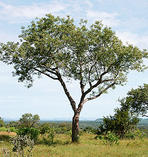
Name
Marula Tree [Scelerocarya birrea]Latin Name
Scelerocarya birreaThe history of the marula tree goes back thousands of years. Archaeological evidence shows the marula tree was a source of nutrition as long as ago as 10,000 years B.C. Marula, Scelerocarya birrea, subspecies caffera, is one of Africa' botanical treasures. In the Pomongwe Cave in Zimbabwe, it is estimated that 24 million marula fruits were eaten.
Not only the fruit, but also the nut, are rich in minerals and vitamins. Legends abound on the multiple uses of the tree, the bark, the leaves, fruit, nut and kernels. Most well known as the fruit that 'drives elephants mad' when dropped to the ground and lightly fermented, marula is a much-loved tree in the veld in Africa. It was a dietary mainstay in South Africa, Botswana and Namibia throughout ancient times.
Description
They are a deciduous tree growing up to 18 m tall. They grow on various types of woodlands on sandy loam soils. They can be found from Ethiopia to Kwazulu-Natal. They produce flowers from September to November and bear fruit from January to March. The fruits are edible and very high in vitamin C. Warthog, elephant, Waterbuck, giraffe and kudu all eat the fruit and leaves of the tree.Uses

The skin of the Marula fruit can be boiled to make a drink or burnt to be used as a substitute for coffee. The wood is soft and used for carving; the inner bark can be used to make rope. Archaeological sites have shown Marula fruit to be used as a food source since ancient times by Africa's tribes.
The bark can also be used to make a light brown dye. Large Saturniid Caterpillars are gathered from this tree for roasting as well as the larvae of the Cerambycid Wood Boring Beetle. Inside the flesh are one or two very small tasty nuts which are rich in protein.
Oil is used as a skin cosmetic. Their green leaves are eaten to relieve heartburn. The bark contains antihistamines and is also used for cleansing by steeping in boiling water and inhaling the steam.
A piece of bark is crushed into a pulp, mixed with cold water and swallowed in the treatment of dysentery and diarrhoea. The bark also is used as a malaria prophylactic.
Fruit
The Marula fruit is very juicy and aromatic and is the size of a small plum. It may be eaten fresh and the flesh has an extremely high vitamin C content. It may also be cooked to produce jam, juices and alcoholic beverages.Where Marula Tree are Found
It is a component of the vegetation type known as 'Bushveld' or Savannah, which is a mixed vegetation type covering the lower slopes of the plateau and the Lowveld of Mpumalanga, including much of the Kruger National Park. Companion plants typically include Umbrella Thorn (Acaia) trees, the Baobab, Fever Trees, the dark-green Mopani, and tall tufted grasses.Marula Tree Facts
Marula trees are dioecious, which means they have a specific gender. This fact contributes to the belief among the Venda that bark infusions can be used to determine the gender of an unborn child. If a woman wants a son the male tree is used, and for a daughter, the female tree. If the child of the opposite gender is born, the child is said to be very special as it was able to defy the spirits.Elephants Drunk on Marula?

People often ask do elephants get drunk on Marula Fruit? Scientists have debunked this popular myth and theorized that an elephant would have to eat about 1500 fermented marulas to get drunk - Read more about the myth of Elephants drunk on marulas
Best Place to See Marula Trees

One of the best places to see Marula Trees in Kruger National Park is Maroela Private Camp, which gets its name from this much-favoured indigenous tree. Enjoy affordable self-catering accommodation at the rustic and remote Maroela Private Camp

